The New York Rangers have been on the move the past two years, having found their way back to consistent playoff contention after a four-year rebuilding project. Unfortunately, the franchise’s all-time list of bad trades is fluid as well.
The Blueshirts’ litany of head-scratching swaps is more than familiar to their fans – and often serves as a prime source of painful discussion for them. Even worse, it’s hardly proven to be a static lineup of disasters, with a major offseason transaction from 2018 putting one of those terrible trades on an upward path through the list as well.
While the Rangers made a deep playoff run in 2024, the club’s five worst trades continue to serve notice of what might have been, both in the past and present. So without further ado, the Blueshirts’ up-to-date directory of their most regrettable swaps.
1. Rick Middleton to Boston Bruins for Ken Hodge, May 26, 1976
This remains the gold standard for the franchise and will require a monumental failure of personnel evaluation to knock it out of the top spot. The first deal made by new general manager John Ferguson was a doozy, with Ferguson swapping young winger Rick Middleton for veteran forward Ken Hodge in order to reunite Hodge with Phil Esposito, who had arrived in a blockbuster deal with Boston in Nov. 1975.
Hodge and Esposito had formed two-thirds of one of the NHL’s most potent lines with the Bruins, and Espo pushed Ferguson to acquire his running mate to again win puck battles along the boards and feed him in the slot. Hodge, at 6-foot-2 and 210 pounds, brought much-needed size to the roster and experience in the dressing room for a Rangers team that was in win-now mode.
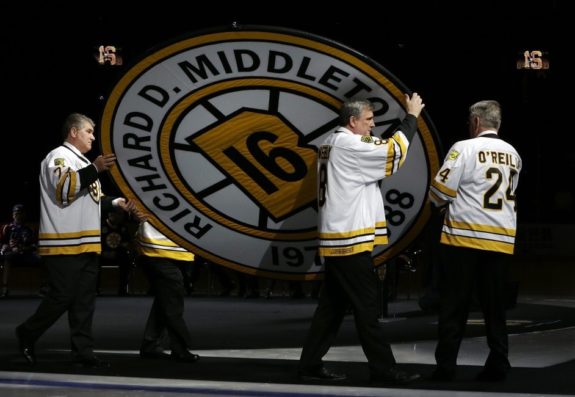
“We think we have enough youth on the Rangers,” Ferguson said then. “Certainly Phil Esposito compliments Kenny and Ken will give the Rangers strength, lots of size and a durable hockey player. I think this trade brings us a step closer to the Stanley Cup.”
All of that reasoning sounds ridiculous now. While Hodge recorded 21 goals and 41 assists in 1976-77, he was 32 at the time of the trade to the Rangers, his best days well behind him. Despite Hodge’s efforts, the Rangers finished last in the Patrick Division that season. He then recorded two goals and four assists in 18 games in 1977-78 before being sent to the American Hockey League and retiring at the end of the season.
What makes the trade even worse was the fact that Middleton, the 14th overall pick in the 1973 Amateur Draft who was 23 when he was shipped to Beantown, was hardly an unproven commodity. He had recorded 46 goals and 44 assists in 124 games over his two seasons in Gotham.
The story of the Rangers’ Middleton failure was even further interwoven with the Bruins. Ferguson had also grown concerned about Middleton’s love of the New York City nightlife and his having supposedly fallen in with veteran Derek Sanderson, another star of Boston’s glory days who had arrived on Broadway for the 1974-75 season. Sanderson’s similar embrace of late nights on the town and significant off-ice troubles were in the process of leading to an early end to his career.
While Ferguson’s concerns about Middleton’s lifestyle might have been legitimate, the decision to simply do away with a rising young star who would have benefited from some organizational guidance and structure was deeply flawed. Middleton responded perfectly to just such a tough-love approach in Boston from coach Don Cherry, who helped him refocus on hockey, clean up his act and become an outstanding two-way player. Middleton’s numbers in 12 years with the Bruins: 402 goals, 496 assists, 881 games, a plus-220 rating.
The Bruins retired Middleton’s No. 16 in 2018. This trade, probably among the worst in NHL history, remains a cautionary tale about the dangers of giving up on young talent.
2. Sergei Zubov and Petr Nedved to Pittsburgh Penguins for Luc Robitaille and Ulf Samuelsson, Aug. 31, 1995
Staying with the theme of trades built on flawed reasoning, this one has climbed the ladder on the Rangers’ list of sad swaps in recent years. Defenseman Sergei Zubov, who led the Rangers with 89 points during the Stanley Cup championship season of 1993-94 – and who added 19 in 22 games in those playoffs – had been a draft steal of general manager Neil Smith in 1990, when the club selected him in the fifth round.
Zubov had keyed the Rangers’ power play in ’93-’94, recording nine goals and 40 assists with the man advantage. He then totaled 36 points in 38 games of the lockout-shortened 1995 season. The Russian, though, appeared overwhelmed and even scared at times during the Blueshirts’ second-round playoff sweep that year at the hands of the Philadelphia Flyers, whose “Legion of Doom” Line of Eric Lindros, John LeClair and Mikael Renberg often targeted Zubov with big hits in the offensive zone during the series.
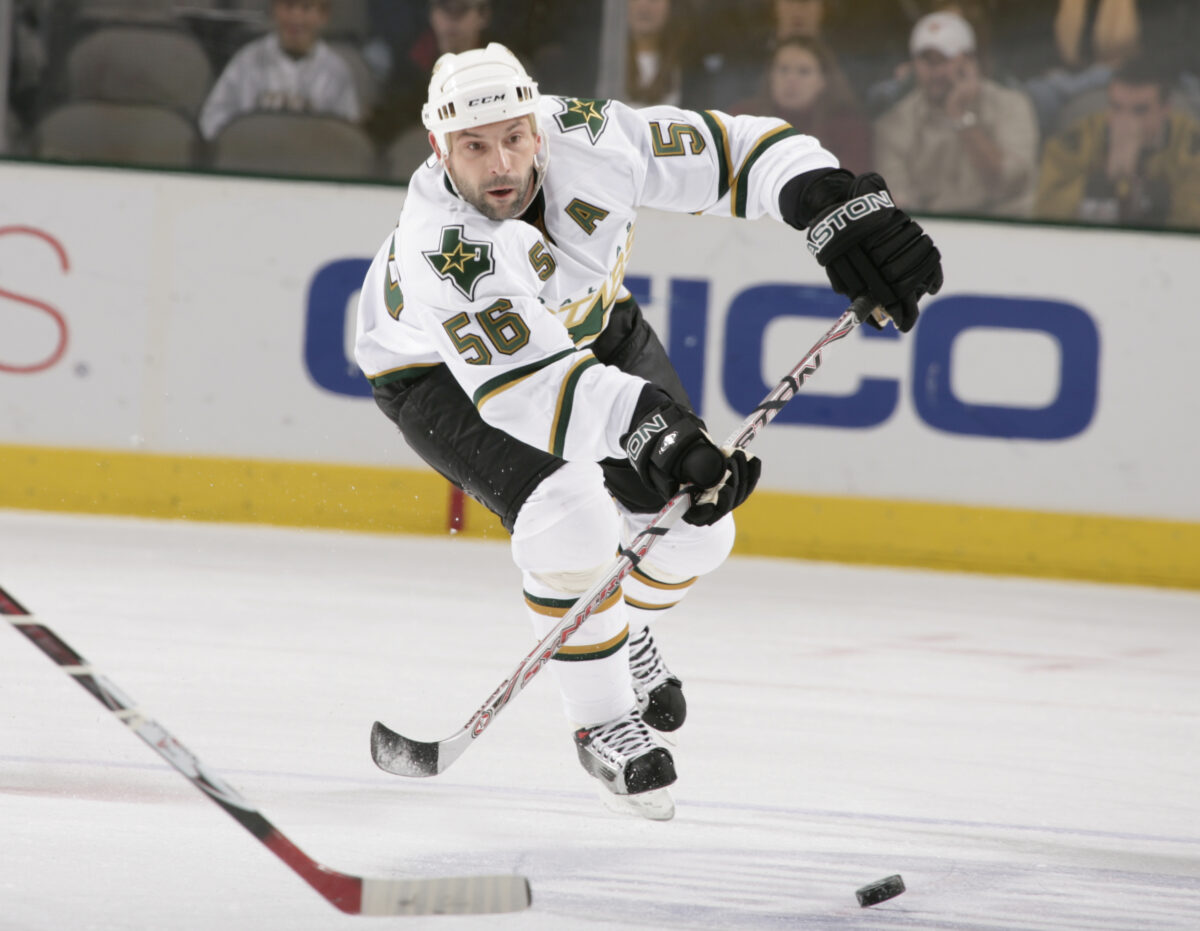
Smith, perhaps concluding that Zubov’s game didn’t fit with where the league’s style of play was headed at the time, attempted to counter the Flyers’ nightmare forward unit by bringing back the physical Ulf Samuelsson as part of the trade. Luc Robitaille was one of the NHL’s great goal-scorers of his era, having recorded more than 40 in each of his eight seasons with the Los Angeles Kings before his one lockout-shortened season with the Penguins.
Zubov spent only one season in Pittsburgh before being traded to the Dallas Stars, but Smith’s reasoning for moving on from him quickly blew up in the GM’s face. It was Zubov’s highly-skilled game that represented where the NHL was going as the league was being progressively influenced by the European style – a trend that Smith, ironically, played a major role in unleashing.
You may also like:
- Rangers GM Chris Drury Learning From Past Mistakes
- Rangers’ Ryan Lindgren Will Be a Key to Team’s Success in 2024-25
- NHL’s 5 Most Underrated General Managers
- Matt Rempe Is Choosing a Dangerous Path to NHL Success
- Rangers’ Most Impactful Trades of All-Time
Zubov went on to total 549 points in in 839 games over 12 years with Dallas and rendered Smith’s worries about his defense unfounded, as he posted a plus-103 rating in that span. Remaining one of the league’s best power-play quarterbacks, Zubov would win his second Stanley Cup in 1998-99. He was inducted into the Hall of Fame in 2019.
Petr Nedved recorded 45 goals and 54 assists in 80 games with the Penguins in 1995-96 in his best NHL season. As for the Rangers’ return in the trade, Robitaille contributed 23 goals and 46 assists for a Blueshirts team that reached the playoffs, but the gaudy production levels that had marked his career to that point were absent. Robitaille’s goal total was by far his lowest in a full season, and his 1996-97 performance wasn’t any better, as he recorded 24 goals and 24 assists in 69 games.
Clearly a poor fit in New York, the Rangers traded Robitaille back to the Kings in August 1997 for forward Kevin Stevens, and Robitaille recaptured some of his earlier magic, delivering four consecutive 30-goal seasons from 1998-2002. Samuelsson played his edgy, disruptive game from the backline well for nearly four seasons on Broadway, but didn’t come close to providing the value Zubov did for the Stars.
Nedved would return to the Rangers in 1998 for a successful second stint that lasted five-plus seasons, but Zubov’s Hall of Fame induction pushes this disaster of a deal up to second on the club’s all-time list.
3. Ryan McDonagh and J.T. Miller to Tampa Bay Lightning for Libor Hajek, Brett Howden, Vlad Namestnikov, 2018 1st-Round Pick and 2019 2nd-Round Pick, Feb. 26, 2018
This head-scratching swap is the most recent mover through the lineup of bad trades, a deal that keeps getting worse. The rise of Vancouver Canucks forward J.T. Miller, who’s emerged as a franchise forward and point-per-game player, has been the biggest gut punch from the trade that keeps on delivering blows to the Blueshirts.
To review: The Rangers, having just formally declared to their fan base their intent to embark on a rebuilding project, made their second big splash in as many days leading up to that season’s trade deadline, following up a multi-player deal with Boston the previous day that has turned out considerably better. Sending away captain Ryan McDonagh – who was still a year away from unrestricted free agency and thus didn’t necessarily have to be moved at that deadline – the team stunningly also agreed to trade Miller, a young power forward who had shown promise since being drafted 15th overall in 2011 but had frustrated the coaching staff with his resistance to instruction.
Miller’s inclusion in the deal seemed inexplicable then, and it came out later that Lightning general manager Steve Yzerman had insisted on him being a part of the trade in order for the Rangers to acquire Libor Hajek, a young defenseman who they saw as the centerpiece of the swap.
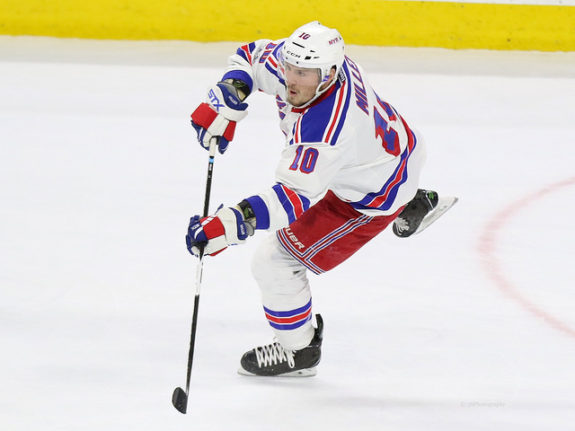
Once again, time has provided a harsh perspective on a trade from which the Rangers are still suffering. Hajek’s NHL career amounted to little, as he totaled four goals, eight assists and a minus-9 rating in 110 games for the Blueshirts. To be blunt, it’s difficult to see what elite skills Hajek possessed that had the front office so enamored with him – and so willing to give up sought-after talent to acquire him. Hajek is now playing for HC Dynamo Pardubice of the Czech Extraliga, seemingly unlikely to return to the NHL.
Center Brett Howden, who at 20 was probably pushed into a more prominent role much earlier than he should have been with the Rangers, mostly struggled for three seasons in a Blueshirt before being traded to the Vegas Golden Knights in July 2021. He’s since emerged as a decent bottom-six contributor for Vegas over three seasons.
Vlad Namestnikov, like Howden a former first-round pick of the Lightning, scored 13 goals in 99 games with the Rangers before moving on. He’s played for six teams since, including a 57-game return to Tampa in 2022-23.
The first-round pick in the deal became promising young defenseman Nils Lundkvist, who was nonetheless traded to the Dallas Stars in September 2022 for a 2023 first-round pick and a 2025 fourth-round selection. The Rangers used the second-rounder on center Karl Henriksson.
Miller, after a sub-par 2018-19 season in Tampa, was traded to the Canucks at the 2019 draft and has since spent five seasons in Vancouver establishing himself as one of the most productive forwards in the league. He’s recorded 402 points in 364 games in the Pacific Northwest and put together a career season in 2023-24, totaling 37 goals and 66 assists. In September 2022, Miller earned a seven-year, $56 million extension to remain a focal point of the Canucks’ attack.
In retrospect, the Rangers seemed more focused on Miller’s early-career hard-headedness than his potential, the latter of which should have become apparent when he scored 44 goals and added 55 assists from 2015-17 – though Miller has since admitted in interviews that he was indeed stubborn and lacked the correct attitude for the NHL while with the Rangers.
While it’s probably fair to say that no team foresaw Miller becoming the force that he is now, the 6-1, 218-pound power forward’s high ceiling always seemed apparent – and, as with Middleton 42 years earlier, the Rangers allowed the growing pains to trump the talent when they decided to trade him.
In giving up Miller, former GM Jeff Gorton compounded his mistake by failing to make the trade hurt for the Lightning, who were acquiring a top-four defenseman and big scoring winger for a run at the Stanley Cup. While Tampa might not have parted with center Brayden Point or defenseman Mikhail Sergachev, both rising young players at the time who have developed into stars, there’s no evidence that Gorton attempted to pry either one away for the two premium assets he was giving up. He instead settled for prospects, a depth forward in Namestnikov and a couple of draft picks.
Though the Lightning also failed to reap the fruits of Miller’s eventual breakout, McDonagh did help them win two Cups as a workhorse on the backline in four full seasons in Tampa.
How would the Rangers look now with Miller joining Chris Kreider – another homegrown, first-round power forward with whom they’ve shown considerably more patience since his 2009 arrival than they did Miller, and has since rewarded it handsomely – in helping to anchor their top six? This ugly deal was the low point of Gorton’s six-year tenure with the Rangers and mars what was an otherwise mostly successful stint on Broadway.
4. Mike Ridley, Kelly Miller and RW Bob Crawford to Washington Capitals for Bob Carpenter and 1989 2nd-Round Pick, Jan. 1, 1987
This trade comfortably occupied the No. 2 spot on the list for years, not comparable to the Middleton mess but still tough to beat. While it has indeed been surpassed, this one was still terrible. The deal epitomized the “Trader Phil” days in the Rangers’ front office, Esposito’s chaotic three-year reign as GM in the late 1980s that was marked by constant roster upheaval.
Mike Ridley had risen from undrafted free agent to a 65-point performance as a rookie in 1985-86. The center followed it up with 36 points in his first 38 games of the 1986-87 season with the Rangers, but Espo’s wandering eye was fixated on Bob Carpenter, who had become the first American-born player to reach the 50-goal mark when he scored 53 in 1984-85 at the age of 21.
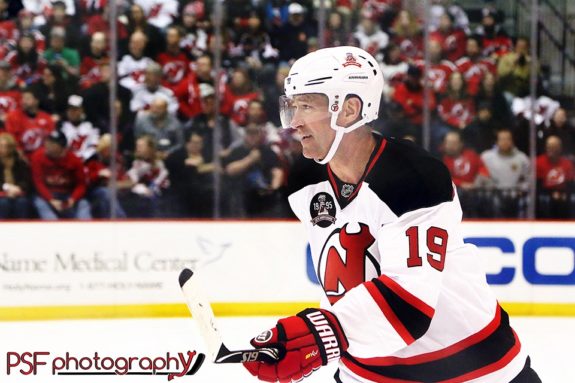
Carpenter’s production, though, dropped alarmingly the next season, as he recorded 27 goals and 29 assists in 80 games. That didn’t deter Esposito, as he pounced on an opportunity to acquire Carpenter when the center’s feuding with Capitals coach Bryan Murray in 1986-87 made him available. Esposito packaged Ridley and speedy 23-year-old two-way winger Kelly Miller, along with Crawford, to Washington in the trade.
Carpenter responded to the change of scenery by recording two goals, eight assists and a minus-11 rating in just 28 games in New York before Esposito lost interest. He shipped Carpenter to the Kings for Marcel Dionne on March 10 of that year, barely three months after obtaining him.
Related: Rangers’ Esposito Era: 5 Best and Worst Trades of ‘Trader Phil’
Ridley would go on to play 7 1/2 seasons in the nation’s capital as a pillar of consistent production, recording 547 points in 588 games with the Caps and scoring 41 goals with 48 assists in his career season of 1988-89. Miller would spend the final 13 years of his 16-year career in Washington, totaling 408 points in 940 games and excelling defensively and on the penalty kill.
Esposito saved at least some face from the debacle by flipping Carpenter for Dionne, who would deliver a 31-goal, 34-assist effort in 1986-87. This deal, though, still richly deserves the “ridiculous” label, one in which the Rangers gave away two outstanding young forwards for 28 games worth of a player whose days as an elite scorer proved to be in the past by age 23 – and who was carrying red flags with him at the time of the trade.
Bob Crawford went scoreless in 12 games for the Capitals in ’86-’87. Amazingly, the Rangers could have turned this trade from one of their worst ever to perhaps their best, had they drafted someone other than Jason Prosofsky with the 1989 second-rounder. A Swedish defenseman by the name of Nicklas Lidstrom was taken 13 spots later by the Detroit Red Wings.
5. Marc Savard to Calgary Flames for Jan Hlavac, Swap of 1999 1st-Round Picks and 1999 3rd-Round Pick, June 26, 1999
The Rangers hit on Marc Savard in the fourth round in the 1995 draft, as the playmaking center began to emerge as a legitimate NHL player with a nine-goal, 36-assist effort in 1998-99. The front office apparently wasn’t sold on Savard’s potential, however, trading him at the draft for the rights to Czech forward Jan Hlavac, a swap of the 11th overall pick (Oleg Saprykin) for the Flames’ ninth overall pick (Jamie Lundmark), and the third-rounder.
After departing New York, Savard went on to record 197 goals and 458 assists for three other teams over 11 years – his 655 points after leaving the Rangers besting Ridley’s total of 547, with both players averaging 0.9 points per game in those spans despite Ridley playing in a more offensive era. This trade could have been even worse had Savard’s career not been cut short due to concussions that forced him from the league at age 33.
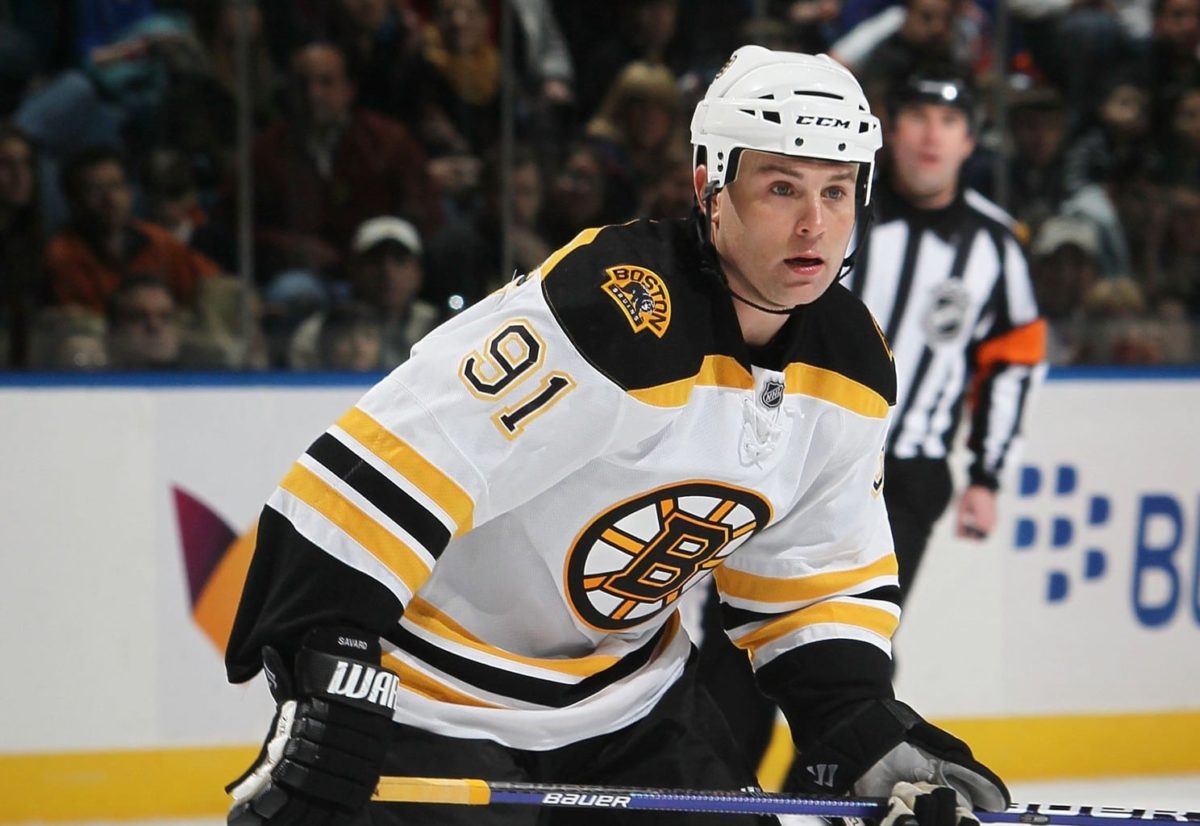
In the four seasons from 2005-09, Savard recorded 96, 87, 78 and 88 points for the Atlanta Thrashers and Bruins. As for the return in the deal, Hlavac posted a 64-point season for the Blueshirts from 2000-01 but totaled only 132 points in 218 games over two stints on Broadway. Lundmark was a bust, recording 99 points in 209 NHL games, while Saprykin wasn’t really any better, with 137 points in 325 contests.
The third-round pick, eventually traded back to the Flames, would become Craig Anderson, would develop into an outstanding goaltender and go on to a 19-season NHL career.
We Left Off the Rangers’ Acquisition of Esposito on Purpose
On paper, the Rangers’ trading of Brad Park, Jean Ratelle and Joe Zanussi for Esposito and defenseman Carol Vadnais on Nov. 7, 1975, tilts hard to the Bruins’ side. Park, the eventual Hall of Fame defenseman, actually had more points with Boston in eight seasons than he did in his eight with the Rangers (417-378). Moreover, Ratelle was hardly finished when he was traded at age 35, totaling 450 points in 419 games wearing the spoked “B” and posting a higher points-per-game average (1.07) than he did in a Blueshirt (0.95) to burnish his Hall of Fame career.
Esposito, while still productive in New York with 404 points in 422 games, was no longer the unstoppable offensive force who delivered five straight seasons of 55 or more goals and 130 or more points from 1970-75. Vadnais was a solid contributor for his nearly seven seasons on Broadway, but he wasn’t Park.
However, Esposito and Vadnais played key roles in the Rangers’ surprise surge to the 1979 Stanley Cup Final, which included a shocking five-game upset of the archrival New York Islanders in the semifinal round. It’s difficult to regard a trade that brought two players crucial to a run at a championship as one of the worst in franchise history, so we’ll let the deal occupy a grey area regarding this topic – and spare Espo an even greater role in the Blueshirts’ litany of worst-ever deals.
Even excluding this one, the Rangers’ lineup of all-time bad trades remains difficult to stomach. It could become all the more painful to endure with Miller – and perhaps Howden and Lundkvist – making that swap look considerably worse in the coming years.
